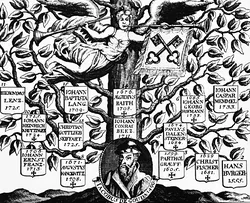
A family book, also known as a family history book or a surname book, is a compiled genealogy book. Researched and written by a family member, several family members, a family association, or a professional genealogist, the family book includes information on a specific ancestor, family, or an ancestor and their descendants that may or may not include the present generation (the generation alive at the time of publication). Family books can include:
- Names of ancestors, descendants, and collateral family members in generation order
- Birth dates and birthplaces
- Marriage dates and marriage places
- Death dates and death places
- Stories, memories, interviews
- Photos
- Document and record images
- Family group records
- Pedigree charts
Family books and the information they contain differ according to the research conducted, the knowledge of the author, and their goals. For example, family books can focus on one ancestor and their life, all descendants of a specific couple, or an immigrant or immigrant couple and their descendants.
Research your ancestors on MyHeritage
Numbering systemsNumbering systems
One aspect that sets family books apart from other types of publications is their use of a numbering system. Numbering systems are used to show relationships between generations. This can simplify understanding family relationships but it can also be confusing for those not accustomed to reading numbered lists of generations. The numbering system in any family book can differ depending on the author's preference. While the author may have made up their own system or used a default system assigned by a genealogy software program, specific systems are recommended for genealogical publications. The following are not the only numbering systems, but they are the most common:
Ahnentafel: This system is also known as the Eytzinger Method, Sosa Method, and the Sosa-Stradonitz Method. Pedigree charts use this system, as well as some family history books. This system uses Arabic numbers, starting with a root person (person #1), and then a person's father will be double the number, and the person's mother will be double + 1. So if you are the #1 person, your father is #2, and your mother is #3.
Register: The system created by the New England Historic Genealogical Society and used in their publications, which uses both Arabic numbers and Roman numerals to number descending generations.
NGSQ: Also known as the Modified Register System. This is a descendant numbering system used by the National Genealogical Society Quarterly. Like the Register system, it combines Arabic numbers and Roman numerals. However, there are stylistic differences, including how children without progeny are handled.
Problems using family booksProblems using family books

The majority of family books contain information that is not sourced, meaning that where the information or facts was originally found is not documented. Unfortunately, that can suggest that the information is made up or based on unsubstantiated family stories. While the author may have used valuable original sources, the reader cannot ascertain the quality of that research because they have not used source citations.
Information found in family books that is unsourced should be treated as clues and not accepted as fact. Like today's online family trees that are not always sourced, always do your own research to verify or disprove information in a family book.
Where to find family booksWhere to find family books
Family books can be found in various places, including as a home source, genealogy websites, digitized book websites, and genealogy libraries.
If the book was published and cataloged by a library, you might find it in a library catalog such as WorldCat. Search the surname/s you are researching to identify possible family books.
WorldCat is a worldwide library catalog. However, it does not include all libraries. It might be helpful to search the library catalog for the family's location.
Genealogy libraries should be checked for family book collections. Major genealogy libraries in the United States include:
- The FamilySearch Library Catalog (Salt Lake City, Utah)
- The Midwest Genealogy Center (Independence, Missouri)
- The Allen County Public Library Genealogy Center (Ft. Wayne, Indiana)
- The Clayton Public Library (Houston, Texas)
- Godfrey Memorial Library (Connecticut)
In addition, large genealogy society libraries can also be beneficial. US examples include the New York Genealogical Biographical Society and the New England Historic Genealogical Society.
When searching the FamilySearch Catalog for Family Books, search by Surname. Catalog entries will include other (but not all) surnames found in a Family Book.
Genealogy libraries have made efforts to digitize family books. Two collections that are found online include the FamilySearch Digital Library and the Allen County Public Library's Genealogy Center collection on Internet Archive.
See alsoSee also
Explore more about family booksExplore more about family books
- MyHeritage – Local and General History
- Cyndi’s List – Numbering Systems
- How to Make a Family Tree Chart or Book on MyHeritage: article from the MyHeritage Knowledge Base
